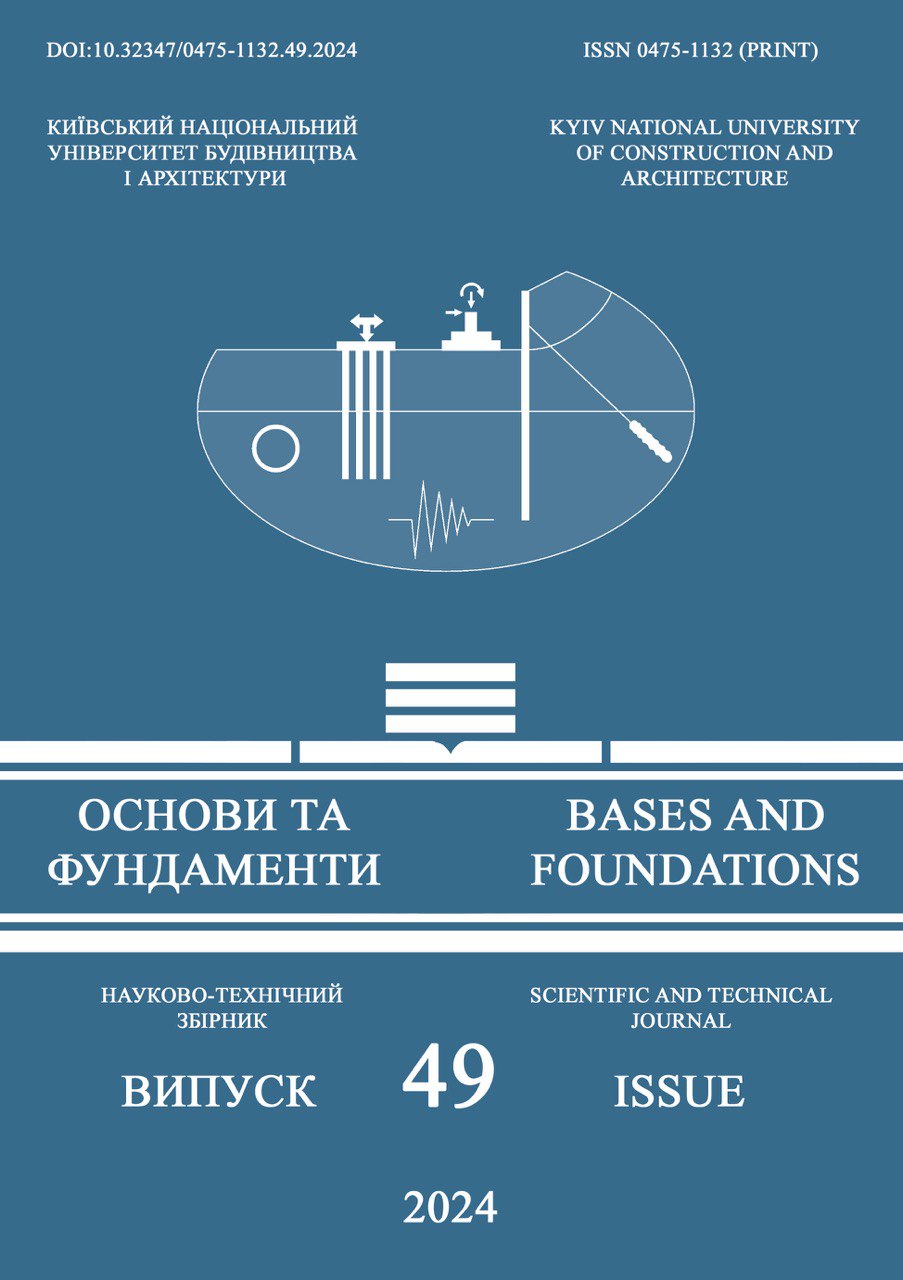Принципи побудови числових моделей для дослідження впливу імпульсних навантажень на заглиблені споруди
Основний зміст сторінки статті
Анотація
Анотація. Сьогодення в Україні зумовило нові проблемні задачі геотехніки розв’язок яких направлений на захист об’єктів критичної інфраструктури від дії вибухових ударних хвиль. Для захисту об’єктів критичної інфраструктури будують захисні споруди, які заглиблюють в ґрунтове середовище. Необхідною умовою забезпечення їх надійної експлуатації є оцінка напружено-деформованого стану системи «ґрунтове середовище-захисна споруда». Важливим є вибір адекватної феноменологічної моделі поведінки матеріалів захисної споруди та ґрунтового середовища, що описують роботу матеріалів при дії імпульсних впливів. У роботі проаналізовано чотири методи побудови числових моделей для розрахунків впливу імпульсних навантажень, це методи:
- Сітка Лагранжа.
- Сітка Ейлера.
- Довільний Лагранжа-Ейлера / Arbitrary Lagrangian-Eulerian (ALE).
- Гідродинаміка плавних частинок* / Smooth Particle Hydrodynamics (SPH).
* - авторський переклад з метою адаптації назви методу українською мовою.
Кожен з методів має свої переваги та недоліки. Сітка Лагранжа дозволяє легко відстежувати межу між матеріалами різних конструкцій, як до початку розрахунку так і після та не вимагає багато часу на обчислення, проте вона не є практичною у випадках значних деформацій моделі із швидкими змінами у часі.
Методи Ейлера та довільний Лагранжа-Ейлера дозволяють моделювати задачі в яких відбувається велике спотворення моделі, наприклад підземний або підводний вибух, а їх недоліком є розмір розрахункової області, значна трудомісткість при налаштування моделі.
Гідродинаміка плавних частинок це безсітковий метод Лагранжа. Його перевагою також є можливість працювати з великими деформаціями моделі, а недоліком трудомісткість та час.
Всі ці методи побудови числової моделі доступні в програмному комплексі LS-Dyna. Аналізуючи розрахунки, що були зроблені в LS-Dyna встановлено, що сіткою Лагранжа доцільно користуватися створюючи модель конструкції з залізобетону або сталі, оскільки їх жорсткість є високою. Для ґрунту доцільно застосовувати методи Ейлера та ALE, оскільки вони дозволяють сильно змінювати свою геометрію моделі під дією вибуху. Різні методи комбінуються між собою для досягнення адекватної роботи моделі та отримання коректних результатів, які будуть максимально відповідати реальній поведінці конструкцій, споруд та матеріалів під дією імпульсних навантажень.
Блок інформації про статтю

Ця робота ліцензується відповідно до Creative Commons Attribution 4.0 International License.
Автори, які публікуються у цьому журналі, погоджуються з наступними умовами: Автори залишають за собою право на авторство своєї роботи та передають журналу право першої публікації цієї роботи на умовах ліцензії Creative Commons Attribution License, котра дозволяє іншим особам вільно розповсюджувати опубліковану роботу з обов'язковим посиланням на авторів оригінальної роботи та першу публікацію роботи у цьому журналі. Автори мають право укладати самостійні додаткові угоди щодо неексклюзивного розповсюдження роботи у тому вигляді, в якому вона була опублікована цим журналом (наприклад, розміщувати роботу в електронному сховищі установи або публікувати у складі монографії), за умови збереження посилання на першу публікацію роботи у цьому журналі. Політика журналу дозволяє і заохочує розміщення авторами в мережі Інтернет (наприклад, у сховищах установ або на особистих веб-сайтах) рукопису роботи, як до подання цього рукопису до редакції, так і під час його редакційного опрацювання, оскільки це сприяє виникненню продуктивної наукової дискусії та позитивно позначається на оперативності та динаміці цитування опублікованої роботи (див. The Effect of Open Access).Посилання
ЛІТЕРАТУРА
LS-DYNA Keyword user’s manual. Liver-more Software Technology Corporation, 2024. URL: https://ftp.lstc.com/anonymous/outgoing/web/ls-dyna_manuals/DRAFT/DRAFT_Vol_I.pdf
LS-DYNA Theory Manual. Livermore Soft-ware Technology Corporation, Livermore 2024. https://ftp.lstc.com/anonymous/outgoing/web/ls-dyna_manuals/DRAFT/DRAFT_Theory.pdf (дата звернення: 04.12.2024).
LSTC. LS-DYNA ALE (Arbitrary Lagrangian Eulerian) Capabilities Fluid Structure Interaction Modeling. 2003. URL: https://ftp.lstc.com/anonymous/outgoing/jday/aletutorial-278p.pdf (дата зв.: 04.12.2024).
Donea J. Arbitrary Lagrangian-Eulerian methods/ J. Donea, A. Huerta, J.-Ph. Ponthot, A. Rodríguez-Ferran // The Ency-clopedia of Computational Mechanics, – Wiley, – 2004 – Vol. 1, Chapter 14 –P. 413-437.
Lars Olovsson, M’hamed Souli, ALE and Fluid-Structure Interaction Capabilities in LS-Dyna. URL: https://lsdyna.ansys.com/wp-content/uploads/attachments/session15-4.pdf (дата звернення: 04.12.2024).
Jean Luc LACOME, Smooth Particle Hydro-dynamics (SPH): A New Features in LS-Dyna. URL: https://lsdyna.ansys.com/wp-content/uploads/attachments/session7-3.pdf (дата звернення: 04.12.2024).
REFERENCES
LS-DYNA (2024) Keyword user’s manual. Livermore Software Technology Corpora-tion. https://ftp.lstc.com/anonymous/outgoing/web/lsdyna_manuals/DRAFT/DRAFT_Vol_I.pdf
LS-DYNA (2024) Theory Manual. Liver-more Software Technology Corporation, Livermore. https://ftp.lstc.com/anonymous/outgoing/web/ls-dyna_manuals/DRAFT/DRAFT_Theory.pdf
LSTC. LS-DYNA ALE (Arbitrary Lagrangian Eulerian) (2003) Capabilities Fluid Structure Interaction Modeling. URL: https://ftp.lstc.com/anonymous/outgoing/jday/aletutorial-278p.pdf
Donea, J., Huerta, A., Ponthot, J.-Ph. and Rodríguez-Ferran, A. (2004) Arbitrary La-grangian-Eulerian methods, The Encyclope-dia of Computational Mechanics, Wiley, Vol. 1, Chapter 14, 413-437.
Lars Olovsson, M’hamed Souli, ALE and Fluid-Structure Interaction Capabilities in LS-Dyna. URL: https://lsdyna.ansys.com/wp-content/uploads/attachments/session15-4.pdf.
Jean Luc LACOME, Smooth Particle Hydro-dynamics (SPH): A New Features in LS-Dyna. URL: https://lsdyna.ansys.com/wp-content/uploads/attachments/session7-3.pdf.
